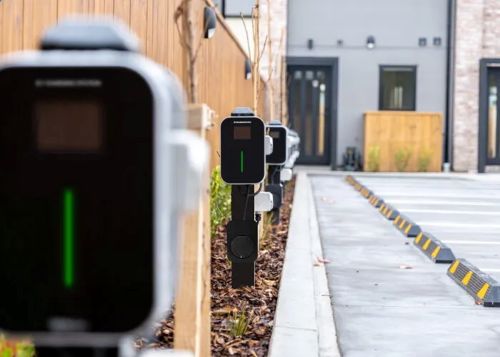


Understanding AC EV Charging: A Practical Guide for Everyday Use
Topper Company, a professional EV charger manufacturer in China, delivers reliable electric vehicle charging stations and comprehensive charging solutions.
As electric vehicles (EVs) continue to grow in popularity, the need for accessible and reliable charging solutions is more important than ever. One of the most widely used methods is AC (Alternating Current) charging, found in homes, workplaces, and many public areas. This guide explains what AC charging is, how it works, and why it’s a smart choice for most EV drivers.
AC charging supplies electricity to an EV using the same type of power found in standard outlets. Unlike DC (Direct Current) fast chargers, AC systems rely on the vehicle’s onboard charger to convert the AC into DC before storing it in the battery. Because it uses the existing grid and infrastructure, AC charging is cost-effective, safe, and ideal for routine use.
Level 1 Charging
Voltage: 120V
Charging Speed: ~2–5 miles of range per hour
Use: Plug into standard household outlets; ideal for overnight charging or short commutes.
Level 2 Charging
Voltage: 240V
Charging Speed: ~10–60 miles of range per hour
Use: Requires a dedicated outlet (like those used for dryers); commonly used in homes, offices, and public spaces.
Level 2 chargers are faster and more versatile, making them the preferred choice for most EV owners.
Power Source: AC power is drawn from the grid.
EV Charger (EVSE): Regulates and manages the connection between the grid and your EV.
Onboard Charger: Converts the AC into DC to charge the battery.
Battery Storage: Energy is stored and used to power the vehicle.
This process takes advantage of existing infrastructure, allowing widespread deployment in residential and commercial settings.
AC charging is ideal when vehicles can remain plugged in for longer periods, such as:
At home overnight
While working from home
During errands (e.g., malls, grocery stores)
At workplace parking lots
Modern AC chargers include built-in protections such as:
Ground fault protection
Overcurrent shutoff
Temperature monitoring
Surge protection
Communication with the EV to adjust charging rates
These ensure safe operation for users and vehicles alike.
Cost-Effective: Lower installation and hardware costs than DC fast chargers.
Gentle on Batteries: Slower speeds mean less heat and stress on the battery, preserving longevity.
Widely Available: Found in homes, apartments, and commercial spaces.
Compatible: Most EVs support AC charging through universal connectors (like J1772).
Low Operating Costs: Consumes less energy per hour and requires minimal maintenance.
Slower Speeds: Not ideal for quick top-ups during road trips.
Installation May Require Upgrades: Level 2 chargers may need dedicated circuits or panel upgrades.
Lower Output: Can take several hours to fully charge larger EV batteries.
| Feature | AC Charging | DC Charging |
|---|---|---|
| Current Type | Alternating Current | Direct Current |
| Speed | Slower (2–60 mph range/hr) | Fast (80% in 20–60 minutes) |
| Use Cases | Home, work, public lots | Highways, long trips |
| Cost | Lower | Higher (equipment & install) |
| Battery Impact | Lower stress | Higher stress & heat |
AC charging is the foundation of everyday EV use. It’s affordable, safe, and perfect for overnight or daytime charging when time is on your side. While DC fast chargers are essential for long-distance travel, AC chargers are what keep most drivers going day to day.
Whether you’re setting up home charging, installing workplace stations, or managing public infrastructure, AC EV chargers are essential to building a clean and efficient transportation future.Know more about Google SEO Directory
